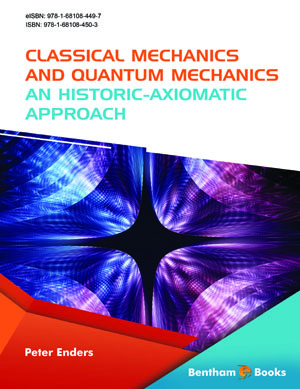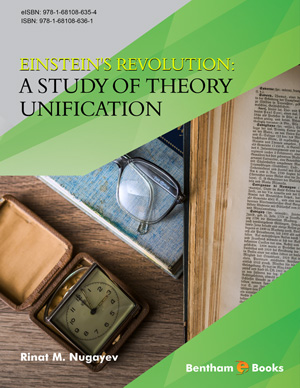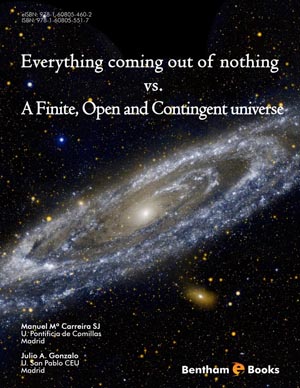List of Contributors In Order of Appearance
Page: v-v (1)
Author: Moataz H. Emam and John F. Donoghue
DOI: 10.2174/97816080521411110101000v
Abstract
Full text available
The Fire in the Equations
Page: 1-36 (36)
Author: Tasneem Zehra Husain
DOI: 10.2174/978160805214111101010001
PDF Price: $15
Abstract
The five parts of this essay are held together by the common theme of unification. Each section focuses on a particular theoretical development and is written in the voice of a scientist living at the time, reflecting on the discoveries of his or her age, what they mean, how they demand a changed worldview, and what might potentially lie in the future. The first section is written as a letter from a young British student at Cambridge, to his sister. He describes to her the wonders of Maxwell 's equations and what they mean, but in terms that his sister, who is an aspiring painter, would be able to relate to. The second section, about relativity, is written by a layman. A New York school teacher who admires Einstein has gone to Battery Park to join the crowds welcoming the Nobel Laureate to America. Whilst waiting for the ship, he thinks about the theories that made this man an international celebrity. The third section is based on the reflections of a young European researcher in Copenhagen in the early 1930's. He sees the greats of quantum mechanics walk the corridors and learns from their conversations, whether directed at him, or overheard. The basic developments are mentioned, including Heisenberg 's uncertainty principle, Pauli 's exclusion principle, Schrodinger 's equation and wave-particle duality. The fourth section is set in the early 1980's. A third-world scientist, early in his career, is visiting the International Center for Theoretical Physics at Trieste, Italy. In a letter to his young children, he talks about particle physics, introduces the Standard Model, and ruminates on how essential collaboration and a conducive atmosphere are for research. The last scientist is a female graduate student at Harvard in the present day. She is beginning to study string theory and is fascinated by the promise of ultimate unification. After a brief review of string theory “ and a mention of the LHC ” she addresses the question of whether or not she thinks this might be physics' last word.
String Theory and the Failure of Unification
Page: 37-41 (5)
Author: Peter Woit
DOI: 10.2174/978160805214111101010037
PDF Price: $15
Abstract
The subject known as string theory by now has a forty-year long history, during which it has evolved into a collection of various active sub-fields in physics and mathematics. With a literature of several tens of thousands of papers, many using highly abstract and specialized mathematical techniques, the degree of complexity involved is hard to over-emphasize. This situation makes it very difficult to evaluate the state of the field and reach conclusions about which ideas have worked out and which haven't. This article will focus on one particular aspect of string theory, the hope that it might provide a unified theory including both general relativity and the Standard Model. The argument will be made that while this is what initially led to the explosion of interest in string theory back in 1984, by now there are solid reasons to believe that attempts to get unification along these lines are doomed to failure. For a more extensive version of the discussion here (with much more in the way of references), see the author's 2006 semi-popular book [1]. In recent years, one segment of the string theory community has reacted to the problems with string theory and unification by conjecturing the existence of a string theory landscape, the existence of which would make it impossible to get testable predictions out of string theory. This move away from the standard scientific method, motivated by an unwillingness to give up long-cherished hopes, holds significant dangers for theoretical physics should it become conventional wisdom.
Can String Theory Survive Complete Falsification?
Page: 42-47 (6)
Author: Moataz H. Emam
DOI: 10.2174/978160805214111101010042
PDF Price: $15
Abstract
The current pursuit of a complete theory of physics, one that incorporates both general relativity and the Standard Model , is wholly based on the power of pure thought. The lack of experimental verification and guidance has forced physicists to explore, and indeed expand, the vast mathematical landscape in search of ideas, one of which happens to be the staggeringly large edifice known as superstring theory. Many of us have specialized into some remote corner of this landscape with little or no hope of that corner ever making contact with reality. So certain questions naturally arise: Why are we doing this? Why is this theory of strings so attractive that, against all odds, it has survived for decades as an active field of physics research? In this article I ask this question, and discuss those achievements of string theory that may just be enough to allow it to survive, even if completely falsified as an explanation of nature.
String Theory in the Classroom. A Case Study
Page: 48-51 (4)
Author: D.H.J. Cho
DOI: 10.2174/978160805214111101010048
PDF Price: $15
Abstract
The first question every instructor asks herself when she teaches a class for the very first time, is what topics should be included and what topics should be discarded. This is usually a tricky balancing act relying not only on conventional wisdom, but also on personal taste and judgment. In this short article, I describe my experience including string theory into a non-science major general education class called “Origins”, offered at Kenyon College during the fall semester of the academic year 2009-2010.
Science Fiction of Everything
Page: 52-78 (27)
Author: Florian Conrady
DOI: 10.2174/978160805214111101010052
PDF Price: $15
Abstract
In this article, I will describe my perspective on the present state of fundamental theoretical physics and my guess on what will be the key elements of future theories of everything. First I will review three important approaches: string theory, loop quantum gravity and noncommutative geometry. I will explain their main ideas and strengths, but also point out what they are still missing on the road to providing a true unification of physics. Based on this, I will speculate about how a future theory of everything could look like: I expect that its basic degrees of freedom will be networks or matrices. Its principal achievements will be the unification of spacetime and fields, and the dynamical generation of spacetime. I will also argue that this scenario opens the way to many interesting conceptual possibilities: the existence of several spacetimes or realities that interact with each other; that spacetime and the laws of nature are not “God-given”, but evolved and contingent; that the very structure of reality could exhibit higher levels of organization. The thread that runs through the discussion will be renormalization : I will start by explaining nonrenormalizability and conclude with remarks on nonperturbative renormalization.
A Vision of Quantum Gravity
Page: 79-93 (15)
Author: Tim A. Koslowski
DOI: 10.2174/978160805214111101010079
PDF Price: $15
Abstract
In this article, I discuss my view of the problem of quantum gravity. I then explain two approaches to solving this problem: Loop quantum gravity and the asymptotic safety scenario, which tackle the problem from opposite ends. Loop quantum gravity tries to describe the fundamental building blocks of spacetime with the hope that the resulting theory may explain gravity as we know it. On the other hand the asymptotic safety scenario considers theories that are as close to gravity as a quantum theory could be and asks whether this setup satisfies the conditions of a fundamental theory. While loop quantum gravity is in a sense a bottom-up approach, the asymptotic safety scenario is a top-down approach to quantum gravity. I explain why the weaknesses of either approach are the strengths of the other, suggesting the main idea of this article; that a merging of both approaches should yield fundamental insight into the problem of quantum gravity. I discuss what the consequences of such a merging could be.
Does History Repeat Itself in a Non-Cyclic Universe?
Page: 94-100 (7)
Author: Sundance Bilson-Thompson
DOI: 10.2174/978160805214111101010094
PDF Price: $15
Abstract
When trying to construct a working theory of quantum gravity, it may be helpful to consider how previous breakthroughs in physics have occurred. What can we learn from the historical progress of astrophysics and particle physics? What role should theory and experiment play as we try to find our way towards this seemingly elusive goal?
Shooting in the Dark
Page: 101-105 (5)
Author: Sabine Hossenfelder
DOI: 10.2174/978160805214111101010101
PDF Price: $15
Abstract
Why are we looking for a Theory of Everything, what do we mean by that, and how do we make headway on it? After addressing the why and what, we briefly survey the phenomenological models used and the search for experimental guidance.
Deciphering Quantum Theory
Page: 106-115 (10)
Author: P. Goyal
DOI: 10.2174/978160805214111101010106
PDF Price: $15
Abstract
Quantum theory poses deep challenges to the mechanical conception of reality that underlies classical physics. Yet today, over eighty years after its creation, its implications for our picture of reality remain enshrouded in uncertainty. In view of the current search for a more comprehensive theory of physics (a so-called theory of everything), it is vital that these implications be clearly elucidated. In this article, I describe the nature of the challenge posed by quantum theory, and outline efforts that have been made to better understand its nonclassical features, such as non-locality. In particular, I discuss the informational perspective, which, through the study of quantum information processing, has provided deep insights into the nature of quantum reality, and has also revitalized the long-standing quest to reconstruct the content of the rather mysterious mathematical formalism of quantum theory from a set of crisp physical principles. Finally, I indicate some implications of recent reconstructive work for the search for a theory of quantum gravity, and, more broadly, for our picture of physical reality.
Abstract
Full text available
Introduction
We live in exciting times. The frontiers of physics have been pushed to unprecedented horizons. The Holy Grail of fundamental physics research today is to find and describe a theory that explains, at least in principle, all physical phenomena, which in turns explains chemistry, biology and other material sciences. This, however, is not without controversy. Currently, the most popular candidate for such a theory is known as string or superstring theory. It suffers from the problem of being a purely mathematical science with no experimental backing, and belief in it has been criticized as bordering on “faith” as opposed to scientific scrutiny. On the other hand the recent switching-on of our most advanced experimental tool, the Large Hadron Collider in Switzerland, gives new hope in our search for clues as to what the universe is made of on a fundamental level. What happened exactly on, or even before, the Big Bang? Where are we coming from and where are we going? Questions that have never been addressed before by physicists. The game is afoot and the search is on. This book contains articles by leading physicists describing the current situation. Among them are proponents as well as opponents of string theory, and proponents of other ideas such as Loop quantum gravity, commutative geometry, and others.


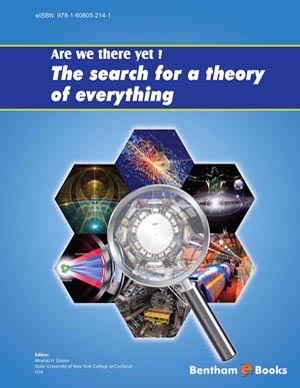



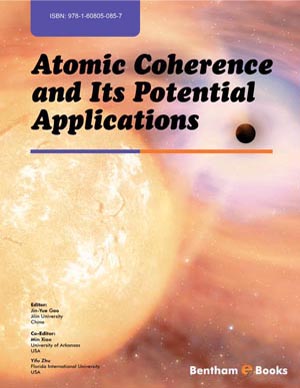
.jpg)
